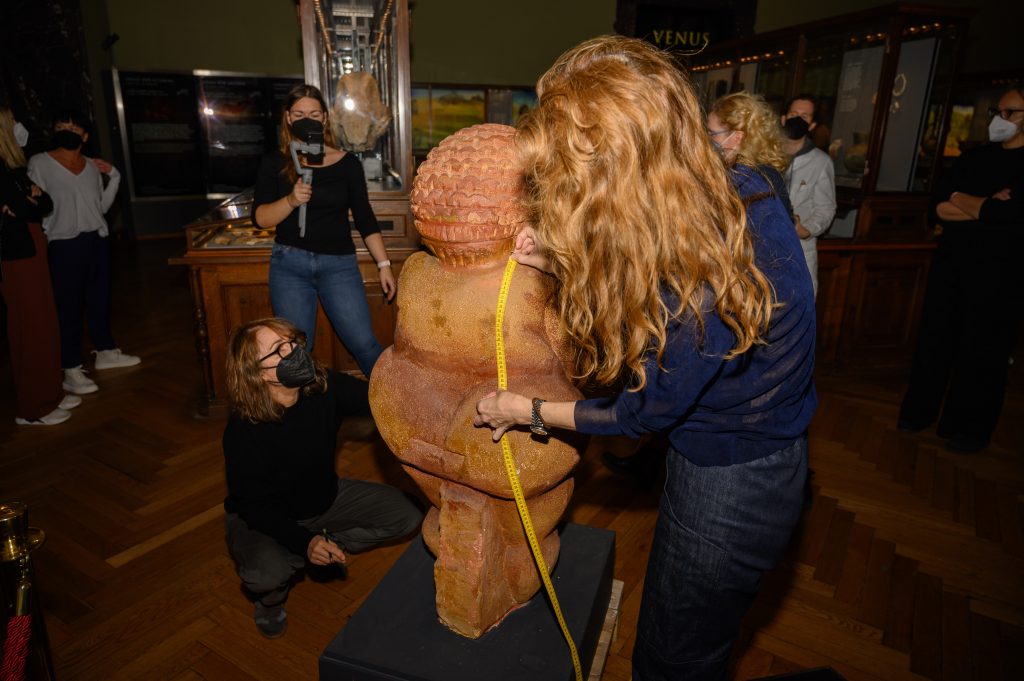
Archetype of femininity, goddess, sex symbol: For millennia, the Venus of Willendorf has excited and fueled the interest of science and the public.
by Denise Meier
Today is the day of the first fitting. She gets her own dress. If someone had told her that almost 30,000 years ago, she probably wouldn’t have believed it. But now, in 2022, the time has finally come. Her small, roundish figure will be wrapped in the most beautiful fabrics that designer Michaela Mayer-Lee has to offer. Mayer considers – black is too plain, red won’t set her apart enough from the background, silver is perfect. It flatters her terracotta skin tone so beautifully.
Directly on her body, meters of fabric are draped, pinned, formed into a dress that she is allowed to wear for the first and probably only time at the Vienna Ball of Science, because normally her place is elsewhere. Normally she stands naked on display, in front of more than 800,000 people a year at the Natural History Museum in Vienna. Dressed, of course, is a replica of the Venus of Willendorf. An oversized copy, because the real Venus measures only about eleven centimeters, barely larger than a coffee cup. (…)
It was found in 1908 during excavations in Willendorf, Lower Austria. Since then 114 years have passed, for the Venus only a tiny fraction of its existence. The artist who created it lived about 29,500 years ago in the Paleolithic Age, the time of hunters and gatherers. He or she was not the only one with the idea of depicting a naked round woman. In total, researchers have discovered about 80 to 100 such Venus figurines from the Paleolithic Age. The sites are located in Portugal, France, Siberia – or in the Wachau. (…)
From extremely slim Egyptian women to the Rubens women of the Baroque era to the Twiggy era of the 1960s – throughout the history of mankind, women have been subject to constant – externally mediated – fluctuations in ideal weight. The pressure to conform to these fluctuations is great. What is apparently always considered desirable is that which is difficult to achieve. In times when large parts of the population are not guaranteed food, plump women are considered particularly attractive. In times of prosperity, thin women are seen as more desirable. As a countermovement to this, the body positivity movement has grown in the 2010s, especially in social networks. Its representatives oppose the trend toward unattainable beauty ideals. One of them is Nunu Kaller. The author and activist has been campaigning for years for people to treat their bodies with acceptance. And with gratitude, “because often you nag about yourself, whereas your body is only the one that lets you experience your life.” (…)
And now she stands there on the pedestal, the dainty little arms cover the bare chest, the head is tilted, the shoulders are pulled forward and the knees are slightly bent. A little bit she looks as if she is ashamed, the Venus, as if maybe she wants to hide. But with all the encouragement, with the deep love and encouragement she receives from her fans and lovers all over the world, she has nothing to be ashamed of. Even if she is probably neither a deity nor the ideal of beauty of her time: If she could speak, she would probably say that she is satisfied with herself, just as she is. And she would pass on this self-confidence to all other women and also men who are sometimes not quite so happy with the body that faces them in the mirror.
The full text can be found in the Ball Magazine 2023
Denise Meier is a graduate of the “Journalism and Media Management” course at FHWien of WKW and has been social media editor at Puls4 since 2022.